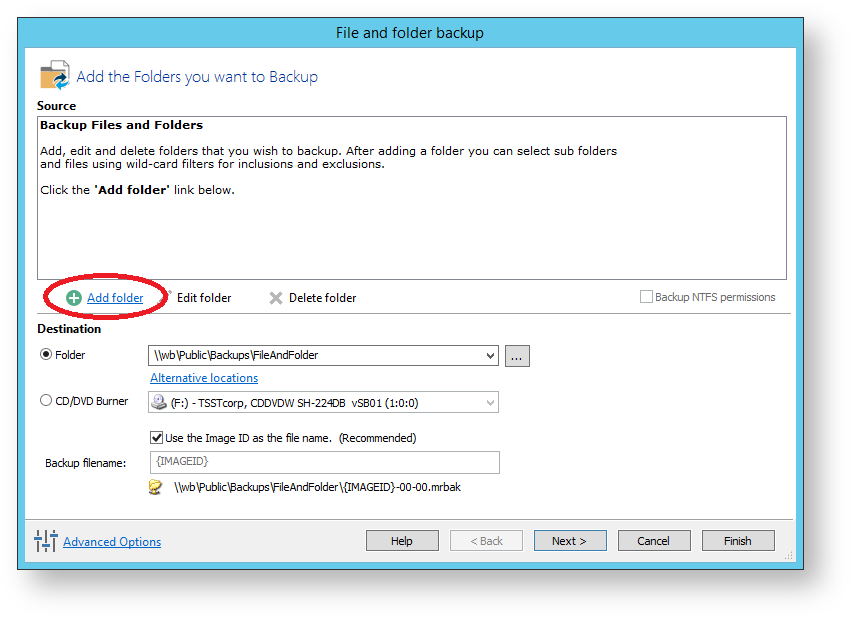A file and folder backup is a useful way to backup your working files, personal files and any precious data. Unlike many other backup solutions Macrium Reflect can even backup open /and locked files by using Microsoft Volume Shadow copy Service (VSS).
In this tutorial I?ll take you through the steps to create a full backup ofyour ?Documents? folder and You can backup your Documents folder and save the backup definition as anXMLfile an XML file for easy re-running and scheduling.
| Note |
|---|
| Info |
To backup your Operating System, Do Not use a File & Folder Backup, you must use an Image Backup. A File / FolderWindows operating system, do not use a file and folder backup, use an image backup, see Creating a backup of your computer. A file and folder backup is not suitable for restoring your Windows OperatingSystemoperating system. |
- Start Macrium Reflect and within
From the
'Backup Tasks' pane at the top left of the application window select 'Backup task bar, select Create a File and Folder backup
' toto start the backup wizard.
Select 'Add folder' as shown below
Select the folder you would like
Select Add folder.Anchor 0 0 The Select Folder to backup dialog appears.
Select the folder you want to backup, or the folder
that containscontaining the
specificfiles you
would likewant to backup.
In this case, the Documents folder has been selected. This will open the 'File and folder backup' dialogue.
This dialogue allows a number ofSeveral different masks and wildcards
tocan be specified to include specific files within the given directory or exclude other files.
For example, by default, all .temp, .tmp, .bak and .~* files are excluded from the backup. In this instance, the default settings shall be used to simply click OK.You should be returned to the original dialogue where you canOption Description Include subfolders Recurse all folders below the backup folder using the specified filters Exclude hidden files and folders Do not backup files or folders that have the Hidden attribute Exclude system files and folders Do not backup files or folders that have the System attribute Add files to include Add a semi-colon separated list of file name filters to include in the backup. Use the asterisk * character as a wild card.
For example; *.doc; *data*; *.xlsAdd files to exclude Add a semi-colon separated list of file name filters to exclude from the backup. Use the asterisk * character as a wild card.
Note: Exclude filters take precedence over include filtersAdd any folders to exclude Add a semi-colon separated list of folder name filters to exclude from the backup. Use the asterisk * character as a wild card.
Filter names can be full path and/or folder names.
For example:
*temp* will exclude all folders with the letters 'temp' anywhere in the folder name
*\data\temp* will exclude all paths where the folder name begins with 'temp' that has a parent folder named 'data'- Click OK
- Repeat to add further individual directories if necessary.
In
the 'the Destination
' section, specify where you would likesection, specify where you want the backup to be made
and then.
Alternative Locations can be used to provide backup rotations or as a fail safe for temporary unavailability of the primary backup destination.- When you have finished adding folders and making all necessary changes, click Next. See also section on Backup Destinations below.A
The Backup Plan Page is shown:Anchor 1 1 Include+ scrollPageId 0A80000A014B7E752054FBC138C1C1CC - The summary screen gives the details of what is being backed up. Click Finish.
You are now given the opportunity to save the backup
details in an XML definitions file. Enter a meaningful name for the backup definition and click OK- The backup should be performed automatically.
Backup Destinations
If you plan to automatically delete your excess backups using Disk Space Management (DSM), such as after Scheduling your backups, care should be taken in choosing the destination folder.
DSM deletes oldest backup sets in the destination folder to make space available for new backups. DSM for one (XML) Backup Definition can delete backups sets created by another Backup Definition for backups placed in the same destination folder. The use of different folders should be part of a retention policy for backups to make sure one backup definition does not delete backups of others if you do not want it to do so. DSM works at folder level but only on the designated destination folder of the backup.
For information: A 'backup set' consists of a full backup and any incrementals or differentials with the same Image ID. The Image ID is the part underlined in the following example backup file name: 69B5FC3F39E0F9F5-00-00.mrbak
Video Tutorial
You can view a Youtube tutorial on backing up files and folders below:
| HTML |
|---|
<iframe width="560" height="349" frameborder="0" src="http://www.youtube.com/embed/a2pBAHxSNGA"></iframe> |
options.
Include+ scrollPageId 0A80000A014D9A75AD084D0E29C6C15E If you want to run the backup at this point, select 'Run this backup now' and click OK.







